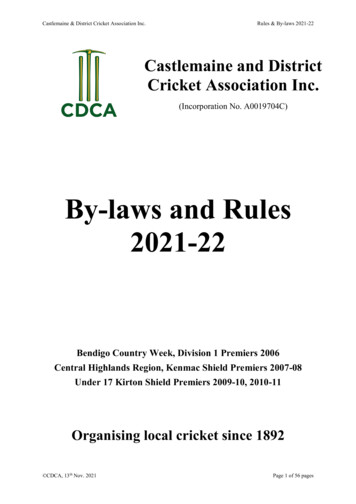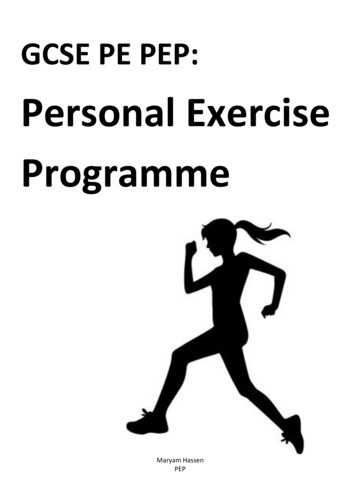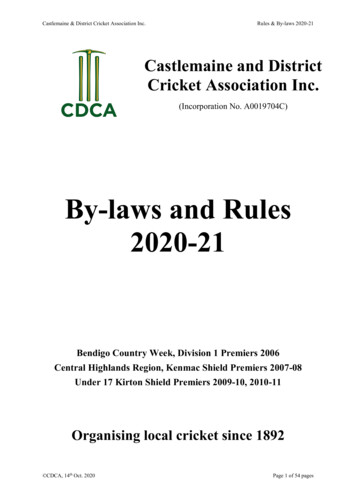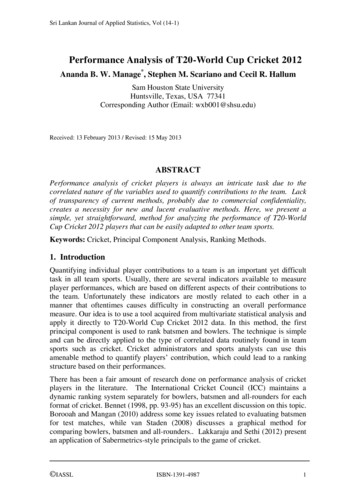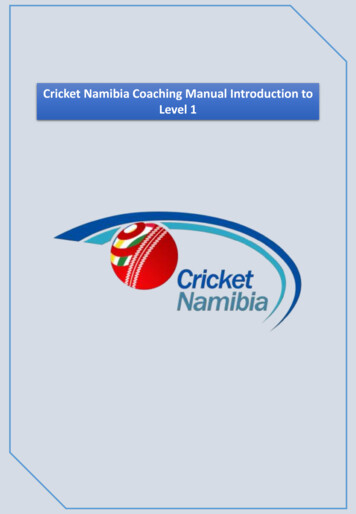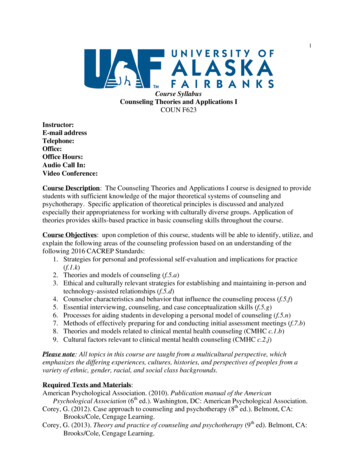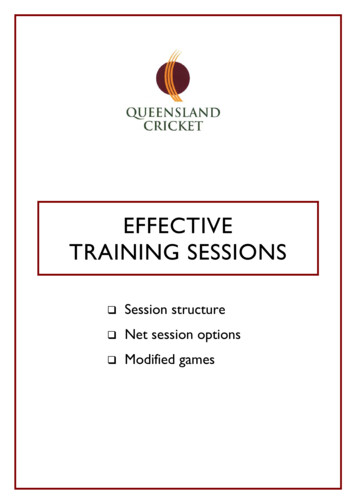
Transcription
EFFECTIVETRAINING SESSIONS Session structure Net session options Modified games
INTRODUCTION Today's cricketers, both young and old, without doubt have totally differentexpectations from their sport than they did as recent as ten years ago. There are many exciting options available nowadays to share the seeminglyever-decreasing leisure time available. Some of these are computer/videogames, water sports, the perceived high action sports, eg. basketball, football,baseball, etc So competition is at a premium and that is why we must look at providingmore enjoyable sporting environments, both on and off the field. One important factor, which attracts us to playing sport, is the satisfaction ofsuccess and improvement. Obtaining small goals and achieving progressivelyprovides great enjoyment and reward. Because of this our training programsshould be directly geared toward constant progression in areas such as skills,physical conditioning and match skills, tactic, etc. Your biggest challenge as a coach is providing an atmosphere, whichcontinually contains a very positive work rate and is enjoyable. It is imperative that we do not lose focus of our training objectives. Crickettraining is about preparing your team to give it the best possible opportunity ofperforming at its optimum level for each contest. Anything you expect them todo in a game you must try and implement at your trainings.PREPARATIONFAILING TO PREPARE IS PREPARING TO FAIL !Spend some time pre-season mapping out a season planner and then breakingdown the plan and mapping out guidelines for each session is an invaluableexercise. Of course, many variables may affect the end result of the session, butto have something to work from is the key.The key is to avoid the monotonous boredom that traditional cricket training inthe nets is renowned for. Too often net training flows the same path; where thebatters pad up for a ten minute hit and everybody else bowls and then trainingcontinues until everybody has batted. The major problem due to excessivetraining duration and boredom a major deterioration of intensity and qualityresults.In an attempt to overcome the monotony of net practice, included in thishandout is a list of various suggestions to assist maximising the benefits of netpractice and also some training alternatives.
VARIETY AND INNOVATIONWe all enjoy a change and it is imperative that we can provide some varietywhether on a small or large scale. Innovation is important, whether provided byyou the coach, or along with collective input from your players and/or coachingresources.One thing is using our imagination in creating new activities but most importantlylet's have a go at implementing new ideas and drills. You really do have nothingto lose. If it doesn't work well, at least you have learnt something and this canoften generate evaluation of further application possibilities.IMAGINATION IS MORE IMPORTANT THAN KNOWLEDGE'ALBERT EINSTEIN'SIMPLE SESSION STRUCTURE WARM UP- SKILL DEVELOPMENT- WARM DOWN-allow body to warm up (dynamic/static)gains attention/motivatesMUST BE EASILY ORGANISEDcombine individual/partners/teamample opportunities for FOCUS/SKILLS to be achievedrefine the new skillreinforce and old skillallow body to warm downTRAINING FORMAT OPTIONSFIELDING PATTERNSFielding patterns are an excellent way for developing the fundamental fieldingskills under controlled and safe conditions. One of the major advantages of thefollowing drills is that they allow a large number of players to be under theguidance of one coach. LINES/GRIDS/SQUARESCHANNELSCIRCLUES/SHAPES
FIELDING GAMESCompetitive sessions can be used to simulate match pressure situations, motivatefielders at training and accelerate skill development.The focus for thecompetition may be:1. TIME TAKEN to complete a set number of rows2. NUMBER of moves completed in SET TIME3. TEAM against TEAMThe following activities may be used either as SKILL DEVELOPMENT routines withoutpressure or competitively between teams: Pick and place; 3/2/1 throws; knock em downRun a two; run outs; leader ballFielding rounders; fielding possession soccerTABLOIDCommencing each time players arrive. Groups will rotate through six stations(variable). For a 90 minute session, groups will spend 15 minutes at each station(nets count as two stations ie. 30 minutes).ACTIVITY NO.(sample 1)1.2.3.4.5.6.CONDITIONING - cricket specificCATCHING - long/mid/shortNETS - bowling in pairs with clear objectivesNETS - batting in pairs with clear objectivesFIELDING - ground and throwingFLEXIBILITY - (PNF, major muscle groups)The six activity stations could be made up of many activities such as throwing atstumps, cradle catching, tennis ball/racquet catching, mini soccer, bat drills,batting off tees, target bowling, running between wickets, agility tests, etc.ACTIVITY LIST FORMATAs a change to regular sessions, organise a list of activities similar to the abovetabloid method, which need to be completed for the session. The activities mayhave a specific focus depending on what stage your training program is at. Theuse of a whiteboard or a pre-drawn list of activities.Equipment will have to be set up for all of the stations and an activity checklistproduced and copied for all players. (Players would be encouraged to work inpairs or perhaps threes, depending on the activities).CENTRE WICKET PRACTICE Use as regularly as your curator allowsSimulate game situation as much as possibleRefer scenarios attached
RUN OUT/FIELDING UNDER PRESSURE GAMESimulating match conditions as much as possible, (including attire) a game inwhich players experience and learn first hand when running a single is possibleand when it is not. All rules are match simulated other than the exception ofcompulsory run. If contact is made by bat to ball then running is compulsory. Theonly exception to the compulsory run rule is if the ball is hit directly back to thebowler.The fielding captain is encouraged to maintain regular fields so as to achieve agood level of match simulation. The benefit of this game activity as a skilldevelopment drill for the fielding team is the enhanced level of pressure situationsthat are regularly presented.A game de-briefing at the conclusion of the game should confirm a greaterawareness of:1. When a run is possible2. Fielding under pressure.DUAL PITCH CRICKET Pairs Dual Pitch cricket is designed to keep all players actively involved in thegame of all times. The game is conducted on 2 pitches adjacent to eachother. 1. There are 10, 12 or 14 players on each team.players on field, 2 players batIn a team of 12 - 102. Team 1 fields on Pitch A and bats on Pitch B. At the same time Teamfields on Pitch B and bats on Pitch A.3. Each team is divided into pairs and each pair bats for 2 overs irrespectiveof wickets lost.4. At he end of their 2 overs the batting pair swaps with 2 of their teammatesfielding on the opposite pitch.5. The batters change ends at the fall of a wicket or after 3 consecutivenon-scoring deliveries. Batters may be dismissed by all the usual meansexcept LBW.6. During the game each player will bowl one over.7. The score is calculated on the product of wickets taken and runsscored.Eg.Team 1 captured 9 wickets and made 62 runsTeam 2 captured 8 wickets and made 70 runsResult :Team 1 9 x 62 558Team 2 8 x 70 560
8. It a team fails to lose a wicket both teams add 1 (one) to their wicket totals.CENTRE WICKET - NET SESSIONIn the format of dual pitch cricket, one team fielding whilst the batting team willbe working purposefully in the nets until their turn to visit the centre wicket.NET SESSIONSAny Traditional net practice lacks purpose and tends to be mundane andmonotonous.Whatever your net practice, set goals so that players are practising with a specificpurpose. This will provide them with immediate feedback of their performance inrelation to the demands of the task.Net practice can provide a perfect opportunity to attend to some specificcoaching demands if everyone is active.NET SESSION ENHANCEMENTSAny number of the ideas below can be integrated into net practice to increasethe value and training benefits of the session.It is important to try to simulate match conditions best we can in most cases.Hints and Tips for Net Sessions: Batters bat in pairs Calls must be clear All running between wickets to be completed at 100% Fiddlers may be marked with fabric/markers around net If dismissed, your time is up Batters pad up well before their turn and shadow bat New ball may be used for opening batters Batters coach other batters when they're not busy Have an umpire adjudicating in each net Batters rotate through pace and spin and bowling machine Bowlers bowl in pairs, 6-8 balls each, resting bowler stretching majormuscle groups Spinners net with wicketkeeper Remove all side nets or back net only for keepers New ball for opening bowlers Bowlers to bowl close to the stumps (inside markers/channels) Bowlers must follow through past a marker Routine: running between wickets and bat swing exercises after net hit Compulsory run for any contact either bat or body Extra stumps for feedback in leaving the ball Hard verse soft
SPOT CALLSCoach may call any one of the following for a selected period (ie. 6 balls, 5minutes): Batters must run singles every ball Batters must hit through the ball along the ground Set a run target ie. 10 runs, 6 balls Balls must be left if possible Bowlers to bowl a maiden over Bowlers to bowl off-stump/leg stump, etc. Bowlers must bowl slower balls only Bowlers must bowl outswingers/inswingers, etc. Lofted strokes only Back foot strokes only Off-side strokes only Charge the bowler Footwork to spinners Bowl around the wicketBowlers and Batters may be set conflicting tasks as a tool to explore varioussituations and outcomes. For example, bowlers being instructed to bowl legstump and batters instructed to hit through the off-side field.Encouragediscussion and evaluation during and after.NET SESSION EXAMPLES1. GAME SCENARIOS - using a match net4 bowlers (pair the bowlers in similar types)2 battersGive a game scenario eg. 5 wickets down, 3 runs and over for the next thirtyovers.Bowlers and batters develop a strategy and share this with you.Bowlers set field, encourage them to try, on occasions, to rush the batsmen.Spinners may bowl their deliveries consecutively. One over on, one teachersthem getting onto length straightaway.Batters emphasis on singles and use of a routine to help them to be optimallyready for each delivery. Allow them to call for runs thereby changing thestrike.2. LETTING THE BALL GO2 batters3 bowlers1 umpireThe aim of the task is for bowlers to deliver as many balls as possible withoutthe batsmen being able to let the ball go. If a batsman is dismissed then a
new batsman enters the net. Rotate batters if no dismissal - possibly right andleft handed to teach bowlers to cope with changing line.3. STARTING AN INNINGSBatsmen are at their most vulnerable early in their innings, however, this is anaspect, which is all but ignored at cricket practice. The following drill seeks toreplicate some aspects of commencing an innings, thereby giving playersextra practice at developing strategies for this situation.4 batters - 2 in net at one time4 bowlers - bowl in pairs, 1 over each then rotateBatsmen aim to get off strike, if dismissed they are rotated. Rotate batters atany time if not dismissed after having faced more than an over and up tothree overs.Continue until all players have had the chance to begin their innings.Also highlights to bowlers the importance of bowling well to new batsmen.4. BATTERS VERSUS BOWLERSCompetitiveness often brings the best out of us via increasing anxiety andarousal levels, which in turn provide a pressure atmosphere and often agreater intensity to training.SKILL DEVELOPMENT ACTIVITIESBATTING (IN PAIRS) Footwork and Balance Drills Front/Backfoot Drives and Defence Length Batting Pad Drill (front foot only) One Handed Grip Decision/Perception Game Bouncer Practice Bowling Machine PracticeFor shot pitched balls (with tennis balls)Spinners (one wheel very slow)Swingers (increased difference between wheel speeds)Variety (mix in various ball types, ie. tennis, hard) Shoulder Positioning Drill
Footwork to Spin Leaving the Ball Rating Drills (in pairs) Target Bowling - Length Target Bowling Line Target Bowling TestProgress to a marked area on the pitch.incorporated using this target method Run-Up Drill Channel Bowling Follow Through Release DrillsProgression - 1. Impart as much backspin as possible2. Vary seam and wrist position for outswing and inswing release3. Bowl to each other attempting to keep seam straight. Coloured Balls/Taped SeamsBOWLINGA points system can be
MODIFIED GAMESTEE LINE
MODIFIED GAMESTEE PAIRS
MODIFIED GAMESDIAMOND CRICKET
RUNNING BETWEEN WICKETSRunning between wickets is a crucial part of the game and poor running can bethe difference of winning and losing a game. Players must always run the first onehard and push one’s into two’s and two into threes.There are 4 main key points listed below:1. Calling Three calls are: Yes, No & Wait. Must be LOUD.Striker to call on most occasionsNon striker calls when striker unsightedBatters need to make a judgement call and make a decision every single ballthey face deciding on whether to run or not. Communication is important asthere maybe more than one run to be taken. Players must have a goodunderstanding of each other's speed.2. Backing up Be moving forward when ball is deliveredShort strides for balance and reaction timeNon striker needs to be ready at all times and only go far enough down to beable to get back if the batter on strike hits straight back to the bowler. The moreground they cover the better chance they have of gaining a run but need to bereminded they can be run out at the bowler end.3. Turning Correctly Carry bat in correct hand for easy turningLow into creaseMake sure the bat crosses over the creaseAccelerate from crease like sprinterWhen running more than a single, batters must learn to be able to carry the bat inboth hands not just their dominant hand. They must turn on the side the ball is sothey can have a clear view as to whether there might be another run.4. Sliding the Bat Must slide early to put doubt in the umpires mindUse the thin side of the bat for speedSliding the bat is crucial and must be done at the appropriate time. Not to early(this will slow the batter down) and not to late (makes the decision easier for theumpire). By using the thin side of the bat this will enable the bat to have betterspeed and less chance of it getting caught in the ground.
RUNNING BETWEEN WICKETS- DRILLS1. Sliding the batPlayers run through and slide at the appropriate time.Set up a cone 10M from a set of stumps. 2-3 sets to be set up depending on yournumbers. Go through until they become successful.2. Turning correctlyPlayers run through a series of 2’s & 3’s that have been hit on either side of thewicket.Set up a cone 10M from a set of stumps. 2-3 sets to be set up depending on yournumbers. Go through until they become successful.3. Backing upSet up two sets of stumps approx 15m apart. Coach sets up a normal batting stanceand takes slow backswing (players commence backing up) and then the coachstimulates a batting stroke and proceeds to make a call - Yes, No or wait. Playersrespond to the call by running through to the other side. Can run singles, 2’s or 3’s.4. CallingTime how long it takes for a player to complete a run.Then set up a stationary ball and fielder so they can judge their run. Then progress toa moving ball and fielder.For a moving ball choose two teams-Batting team and a fielding team. Bowler(Coach) lobs easy ball to batter who places the shot and decides on a call. Fielderstake it in turns of fielding the ball and throwing at the stumps while the batters rotateas well.Can run quick singles or 2’s and 3’s for variation.5. Modified GamesRunning RoundersRun out/ Fielding gameRuns vs Catching
Fielding rounders; fielding possession soccer TABLOID Commencing each time players arrive. Groups will rotate through six stations (variable). For a 90 minute session, groups will spend 15 minutes at each station (nets count as two stations ie. 30 minutes). ACTIVITY NO. 1. CONDITIONING - cricket specific (sample 1) 2. CATCHING - long/mid .
